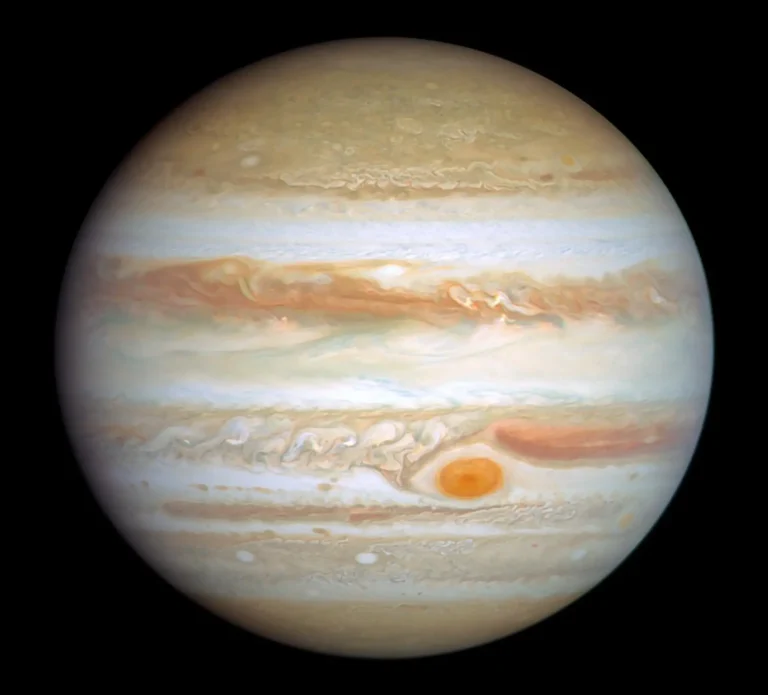Jupiter: The Giant of Our Solar System
When we look up at the night sky and spot a bright, steady light — one that doesn’t twinkle like the stars — we might be seeing Jupiter, the king of all planets. Massive, mysterious, and mesmerizing, Jupiter isn’t just another planet; it’s a cosmic heavyweight that has shaped the solar system as we know it.

What Makes Jupiter So Special?
Jupiter is the fifth planet from the Sun, sitting between Mars and Saturn. But what truly sets it apart is its immense size. It’s more than 11 times wider than Earth, and if you could combine all the other planets in the solar system, Jupiter would still outweigh them. Yet, for all its size, it’s not made of rock or soil. Jupiter is a gas giant, composed mainly of hydrogen and helium — the same elements found in stars.
Its thick, stormy atmosphere is a canvas of swirling clouds, dramatic bands, and powerful lightning storms. These aren’t just beautiful patterns; they’re signs of intense weather systems that have lasted for centuries. The most famous of these is the Great Red Spot, a giant storm larger than Earth that has been raging for at least 350 years.
Role of Jupiter in Our Solar System
Jupiter is more than a scientific curiosity — it’s a guardian of the inner solar system. Its powerful gravity acts as a cosmic shield, pulling in comets and asteroids that might otherwise threaten Earth. Some scientists even believe we might not be here without Jupiter protecting our planet from frequent catastrophic impacts in the early days of the solar system.
Its gravity also holds a vast system of moons, many of which are fascinating worlds in their own right. Among them, Europa is of particular interest because it likely hides a liquid ocean beneath its icy surface — a potential home for life beyond Earth.
Exploration and Discovery
Humans have been observing Jupiter for centuries. In 1610, Galileo Galilei used a telescope to discover its four largest moons — now known as the Galilean moons: Io, Europa, Ganymede, and Callisto. These moons alone have changed our understanding of the universe.
Since then, multiple missions have flown by or orbited Jupiter. Today, NASA’s Juno spacecraft is in orbit around the planet, capturing stunning images and collecting data about its atmosphere, magnetosphere, and internal structure. These missions help us understand not only Jupiter but also the origins of the solar system.
Space Missions to Jupiter
Jupiter has long fascinated scientists and astronomers, and over the decades, several space missions have been launched to study the planet up close. These missions have revolutionized our understanding of the gas giant and its many moons.
- Pioneer 10 and 11 (1973–1974):
These were the first spacecraft to fly past Jupiter. Pioneer 10 provided the first direct images of the planet and measured its radiation environment. Pioneer 11 followed a year later, offering additional data and setting the stage for future exploration. - Voyager 1 and 2 (1979):
The twin Voyager spacecraft conducted detailed flybys, capturing high-resolution images of Jupiter’s atmosphere, rings, and moons. Their discoveries included active volcanoes on Io and evidence of a subsurface ocean on Europa. - Galileo Orbiter (1995–2003):
Galileo was the first spacecraft to orbit Jupiter. It spent eight years studying the planet and its major moons. Galileo dropped a probe into Jupiter’s atmosphere, giving us direct measurements of its composition and weather patterns. - New Horizons (2007):
Although New Horizons was en route to Pluto, it performed a gravity assist maneuver around Jupiter. During its brief encounter, it collected data on Jupiter’s storms, moons, and magnetosphere, capturing stunning images in the process. - Juno Mission (2016–Present):
Launched by NASA, Juno is currently in orbit around Jupiter. Its mission is to study the planet’s atmosphere, magnetic field, auroras, and deep internal structure. Juno has provided some of the most breathtaking close-up images of Jupiter and continues to send back vital data, reshaping our understanding of gas giants.
What Lies Beneath?
Unlike Earth, Jupiter doesn’t have a solid surface. As you go deeper into its atmosphere, the pressure and temperature increase dramatically, turning hydrogen gas into a strange, metallic liquid. At the center, scientists believe there might be a dense core made of rock and metal, but it’s still one of Jupiter’s many secrets.
Its magnetic field is the strongest of any planet, and it creates radiation belts so powerful that spacecraft must be specially shielded to survive near them. This magnetic environment also causes auroras — beautiful light displays near the planet’s poles, similar to the Northern Lights on Earth, but far more intense.
FAQ's / Facts about Jupiter:
What is Jupiter made of?
Jupiter is mostly made of hydrogen and helium, with no solid surface. Deep inside, it may have a small, dense core. To Read more about the Jupiter’s Composition check our article about the “Composition of Jupiter“.
Can Jupiter support life?
Not Jupiter itself — it’s too hot and inhospitable. However, some of its moons (especially Europa) might have the right conditions for life.
Why is Jupiter important?
Jupiter’s gravity protects Earth from many incoming space objects. It also provides clues about how giant planets and solar systems form.
How many moons does Jupiter have?
As of 2025, Jupiter has 95 confirmed moons, and scientists are still discovering more. To Read more about the Jupiter’s Moon check our article about the “Moons of Jupiter“.
Can we see Jupiter from Earth?
Yes! Jupiter is often visible to the naked eye and appears as a bright, non-twinkling object in the night sky.